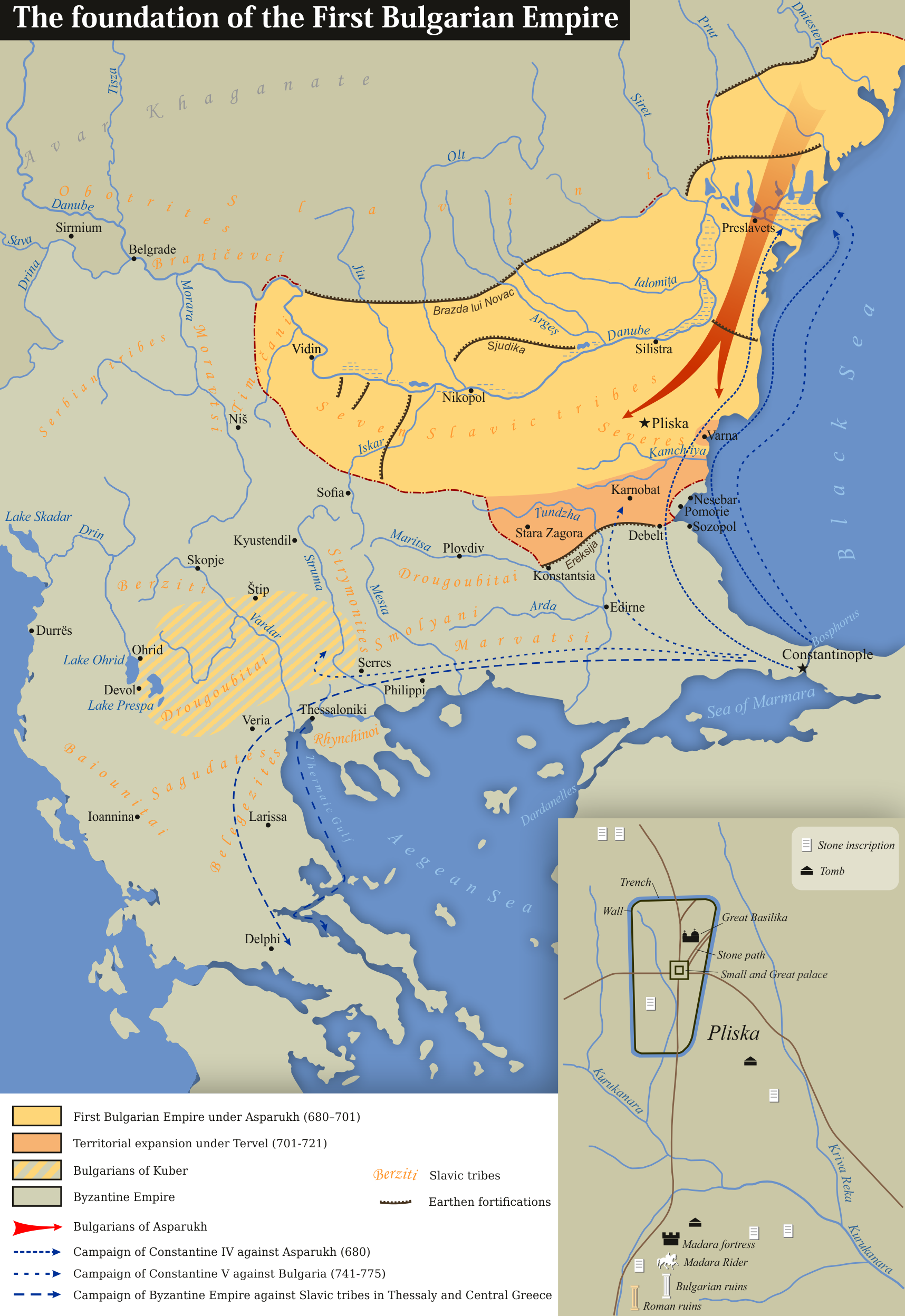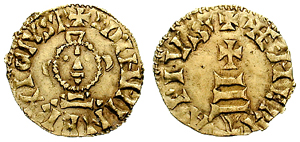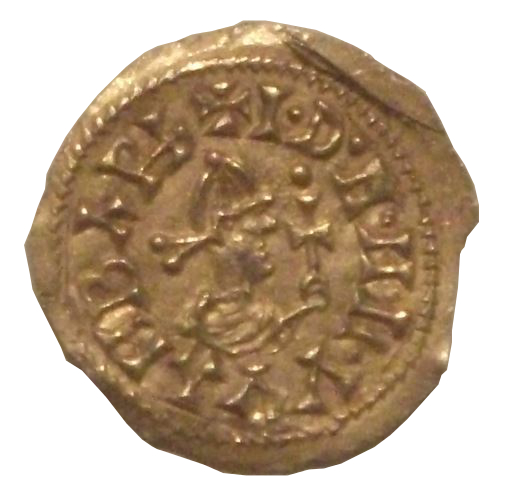|
680
__NOTOC__ Year 680 ( DCLXXX) was a leap year starting on Sunday (link will display the full calendar) of the Julian calendar. The denomination 680 for this year has been used since the early medieval period, when the Anno Domini calendar era became the prevalent method in Europe for naming years. Events By place Byzantine Empire * Byzantine–Bulgarian War: The Bulgars under Asparukh subjugate the country of current-day Bulgaria, north of the Balkan Mountains. Emperor Constantine IV leads a combined land and sea operation against the invaders and besieges their fortified camp in Dobruja. * Battle of Ongal: The Byzantine army (25,000 men) under Constantine IV is defeated by the Bulgars and their Slavic allies in the Danube Delta. Bulgar cavalry force the Byzantines into a rout, while Constantine (suffering from leg pain) travels to Nesebar to seek treatment. Europe * King Wamba is deposed after an 8-year reign, and forced to retire to a monastery. He is succe ... [...More Info...] [...Related Items...] OR: [Wikipedia] [Google] [Baidu] |
Battle Of Ongal
The Battle of Ongal took place in the summer of 680 in the Ongal area, an unspecified location in and around the Danube delta near the Peuce Island, present-day Tulcea County, Romania. It was fought between the Bulgars, who had recently invaded the Balkans, and the Byzantine Empire, which ultimately lost the battle. The battle was crucial for the creation of the First Bulgarian Empire. Origins of the conflict In 632, Khan Kubrat united the Bulgars into the state of Old Great Bulgaria along the coasts of the Black Sea and Caspian Sea. After his death in the 660s his sons divided his kingdom amongst themselves. Batbayan, the eldest son, inherited the throne in Poltava but was defeated by and submitted to the rule of his ambitious relative Cozarig ( Kotrag) who had undermined the state's unity by leading his Don-Volga Khazars (Kutrigs) in expansion campaigns extending his empire to the north where Volga Bulgaria would eventually remain. The third son Asparuh marched westward and set ... [...More Info...] [...Related Items...] OR: [Wikipedia] [Google] [Baidu] |
Visigothic Kingdom
The Visigothic Kingdom, officially the Kingdom of the Goths ( la, Regnum Gothorum), was a kingdom that occupied what is now southwestern France and the Iberian Peninsula from the 5th to the 8th centuries. One of the Germanic peoples, Germanic successor states to the Western Roman Empire, it was originally created by the settlement of the Visigoths under King Wallia in the province of Gallia Aquitania in southwest Gaul by the Roman government and then extended by conquest over all of Hispania. The Kingdom maintained independence from the Eastern Roman or Byzantine Empire, whose attempts to re-establish Roman authority in Hispania were only partially successful and short-lived. The Visigoths were Romanization (cultural), romanized central Europeans who had moved west from the Danube, Danube Valley. They became foederati of Rome, and wanted to restore the Roman order against the hordes of Vandals, Alans and Suebi. The Fall of the Western Roman Empire, Western Roman Empire fell in 47 ... [...More Info...] [...Related Items...] OR: [Wikipedia] [Google] [Baidu] |
Erwig
Erwig ( la, Flavius Ervigius; after 642 – 687) was a king of the Visigoths in Hispania (680–687). Parentage According to the 9th-century '' Chronicle of Alfonso III'', Erwig was the son of Ardabast, who had journeyed from the Byzantine Empire to Hispania during the time of Chindasuinth, and married Chindasuinth's niece Goda. Ardabast (or Artavasdos), was probably an Armenian or Persian Christian exile in Constantinople or in Byzantine Africa. In Hispania he was made a count. Seventeenth-century Spanish genealogist Luis Bartolomé de Salazar y Castro gave Ardabast's father as Athanagild, the son of Saint Hermenegild and Ingund, and his mother as Flavia Juliana, a daughter of Peter Augustus and niece of the Emperor Maurice. This imperial connection is disputed by Christian Settipani, who says that the only source for Athanagild's marriage to Flavia Julia is José Pellicer, who he claims to be a forger. Succession After his predecessor Wamba had taken the monastic habit wh ... [...More Info...] [...Related Items...] OR: [Wikipedia] [Google] [Baidu] |
Constantine IV
Constantine IV ( la, Constantinus; grc-gre, Κωνσταντῖνος, Kōnstantînos; 650–685), called the Younger ( la, iunior; grc-gre, ὁ νέος, ho néos) and sometimes incorrectly the Bearded ( la, Pogonatus; grc-gre, Πωγωνᾶτος, Pōgōnãtos) out of confusion with his father, was Eastern Roman emperor from 668 to 685. His reign saw the first serious check to nearly 50 years of uninterrupted Islamic expansion, most notable when he successfully defended Constantinople from the Arabs. His calling of the Sixth Ecumenical Council saw the end of the monothelitism controversy in the Byzantine Empire; for this, he is venerated as a saint in the Eastern Orthodox Church, with his feast day on September 3.September 3/September 16 Orthodox Calendar (PRAVOSLAVIE.RU). Early career The ...[...More Info...] [...Related Items...] OR: [Wikipedia] [Google] [Baidu] |
Wamba (king)
Wamba (Medieval Latin: ''VVamba, Vamba, Wamba''; 643 – 687/688) was the king of the Visigoths from 672 to 680. During his reign, the Visigothic kingdom encompassed all of Hispania and part of southern Gaul known as Septimania. According to Herwig Wolfram, ''Wamba'' means "big paunch" in Gothic (like German: "Wampe", cognate to English "womb") and may have been a nickname. Both Julian of Toledo in his ''Historia Wambae'' (''History of Wamba'') and the decisions of the eleventh Council of Toledo, held under Wamba's auspices, only refer to the king as Wamba. History Military events After ascending the throne on 1 September 672, Wamba faced a revolt from Hilderic, governor of Nîmes, who had himself aspired to the kingship. Hilderic was supported by Gunhild, Bishop of Maguelonne. Wamba sent the dux (general) Paul to put down the rebels, but upon his arrival at Narbonne, he induced his officers to renounce their loyalty to Wamba and elect him king as Flavius Paulus. He was joined ... [...More Info...] [...Related Items...] OR: [Wikipedia] [Google] [Baidu] |
Cædwalla Of Wessex
Cædwalla (; 659 – 20 April 689 AD) was the King of Wessex from approximately 685 until he abdicated in 688. His name is derived from the Welsh Cadwallon. He was exiled from Wessex as a youth and during this period gathered forces and attacked the South Saxons, killing their king, Æthelwealh, in what is now Sussex. Cædwalla was unable to hold the South Saxon territory, however, and was driven out by Æthelwealh's ealdormen. In either 685 or 686, he became King of Wessex. He may have been involved in suppressing rival dynasties at this time, as an early source records that Wessex was ruled by underkings until Cædwalla. After his accession Cædwalla returned to Sussex and won the territory again. He also conquered the Isle of Wight, gained control of Surrey and the kingdom of Kent, and in 686 he installed his brother Mul as king of Kent. Mul was burned in a Kentish revolt a year later, and Cædwalla returned, possibly ruling Kent directly for a period. Cædwalla was ... [...More Info...] [...Related Items...] OR: [Wikipedia] [Google] [Baidu] |
Pippin Of Herstal
Pepin II (c. 635 – 16 December 714), commonly known as Pepin of Herstal, was a Frankish statesman and military leader who de facto ruled Francia as the Mayor of the Palace from 680 until his death. He took the title Duke and Prince of the Franks upon his conquest of all the Frankish realms. The son of the powerful Frankish statesman Ansegisel, Pepin worked to establish his family, the Pippinids, as the strongest in Francia. He became Mayor of the Palace in Austrasia in 680. Pepin subsequently embarked on several wars to expand his power. He united all the Frankish realms by the conquests of Neustria and Burgundy in 687. In foreign conflicts, Pepin increased the power of the Franks by his subjugation of the Alemanni, the Frisians, and the Franconians. He also began the process of evangelisation in Germany. Pepin's statesmanship was notable for the further diminution of Merovingian royal authority, and for the acceptance of the undisputed right to rule for his family. Therefo ... [...More Info...] [...Related Items...] OR: [Wikipedia] [Google] [Baidu] |
Byzantine–Bulgarian Wars
The Byzantine–Bulgarian wars were a series of conflicts fought between the Byzantines and Bulgarians which began when the Bulgars first settled in the Balkan peninsula in the 5th century, and intensified with the expansion of the Bulgarian Empire to the southwest after 680 AD. The Byzantines and Bulgarians continued to clash over the next century with variable success, until the Bulgarians, led by Krum, inflicted a series of crushing defeats on the Byzantines. After Krum died in 814, his son Omurtag negotiated a thirty-year peace treaty. Simeon I had multiple successful campaigns against the Byzantines during his rule from 893 to 927. His son Peter I negotiated another long-lasting peace treaty. His rule was followed by a period of decline of the Bulgarian state. In 971 John I Tzimiskes, the Byzantine emperor, subjugated much of the weakening Bulgarian Empire by defeating Boris II and capturing Preslav, the Bulgarian capital. Samuel managed to stabilize the Bulgarian state w ... [...More Info...] [...Related Items...] OR: [Wikipedia] [Google] [Baidu] |
Asparukh Of Bulgaria
Asparuh (also ''Ispor''; bg, Аспарух, Asparuh or (rarely) bg, Исперих, Isperih) was а ruler of Bulgars in the second half of the 7th century and is credited with the establishment of the First Bulgarian Empire in 681. Early life The '' Nominalia of the Bulgarian khans'' states that Asparuh belonged to the Dulo clan and reigned for 61 years. This long period cannot be accepted as accurate due to chronological constraints, and may indicate the length of Asparuh's life. According to the chronology developed by Moskov, Asparuh would have reigned 668–695. Other chronologies frequently end his reign in 700 or 701 but cannot be reconciled with the testimony of the ''Namelist''. According to the Byzantine sources, Asparuh was a younger son of Kubrat, who had established a spacious state ("Great Bulgaria") in the steppes of modern Ukraine. Asparuh may have gained experience in politics and statesmanship during the long reign of his father, who probably died in 66 ... [...More Info...] [...Related Items...] OR: [Wikipedia] [Google] [Baidu] |
Austrasia
Austrasia was a territory which formed the north-eastern section of the Merovingian Kingdom of the Franks during the 6th to 8th centuries. It was centred on the Meuse, Middle Rhine and the Moselle rivers, and was the original territory of the Franks, including both the so-called Salians and Rhineland Franks, which Clovis I conquered after first taking control of the bordering part of Roman Gaul, now northern France, which is sometimes described in this period as Neustria. In 561, Austrasia became a separate kingdom within the Frankish kingdom and was ruled by Sigebert I. In the 7th and 8th centuries it was the powerbase from which the Carolingians, originally mayors of the palace of Austrasia, took over the rule of all Franks, all of Gaul, most of Germany, and northern Italy. After this period of unification, the now larger Frankish empire was once again divided between eastern and western sub-kingdoms, with the new version of the eastern kingdom eventually becoming the foun ... [...More Info...] [...Related Items...] OR: [Wikipedia] [Google] [Baidu] |
Dobruja
Dobruja or Dobrudja (; bg, Добруджа, Dobrudzha or ''Dobrudža''; ro, Dobrogea, or ; tr, Dobruca) is a historical region in the Balkans that has been divided since the 19th century between the territories of Bulgaria and Romania. It is situated between the lower Danube River and the Black Sea, and includes the Danube Delta, Romanian coast, and the northernmost part of the Bulgarian coast. The territory of Dobruja is made up of Northern Dobruja, which is part of Romania, and Southern Dobruja, which is part of Bulgaria. The territory of the Romanian region Dobrogea is organised as the counties of Constanța and Tulcea, with a combined area of and a population of slightly less than 900,000. Its main cities are Constanța, Tulcea, Medgidia and Mangalia. Dobrogea is represented by dolphins in the coat of arms of Romania. The Bulgarian region Dobrudzha is divided among the administrative regions of Dobrich and Silistra; the following villages of Razgrad Province: ... [...More Info...] [...Related Items...] OR: [Wikipedia] [Google] [Baidu] |
Seven Slavic Tribes
The Seven Slavic tribes ( bg, Седемте славянски племена, Sedemte slavyanski plemena), or the Seven clans ( bg, Седемте рода, Sedemte roda, links=no) were a union of Slavic tribes in the Danubian Plain, that was established around the middle of the 7th century and took part in the formation of the First Bulgarian Empire together with the Bulgars in 680−681. Since its establishment it faced attacks of the Byzantine Empire. The Bulgars crossed the Danube and in the 670's they concluded an alliance with the Slavic Union. Theophanes writes that the Bulgars became masters of the Slavs. The Slavic Union recognized the sovereignty of Khan Asparukh and together, in the spring of 681, they won a major victory over the Byzantines. In the late 7th century the Seven tribes were assigned the defence of the newly established Bulgar Khanate's western and northwestern border (the Iskar River up to its mouth in the Danube) against Avar raids, as well as some ... [...More Info...] [...Related Items...] OR: [Wikipedia] [Google] [Baidu] |





